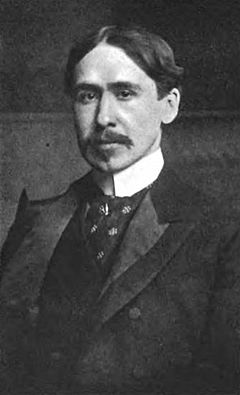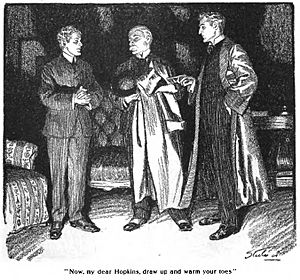Frederic Dorr Steele facts for kids
Quick facts for kids
Frederic Dorr Steele
|
|
|---|---|

Frederic Dorr Steele (circa 1901)
|
|
| Born | August 6, 1873 Eagle Mills, Michigan, U.S.
|
| Died | July 6, 1944 (aged 70) Kips Bay, New York, U.S.
|
| Nationality | American |
| Education | Art Students' League National Academy of Design |
Frederic Dorr Steele (born August 6, 1873 – died July 6, 1944) was an American artist. He was famous for drawing pictures for books and magazines. He is best known for his amazing work on Arthur Conan Doyle's Sherlock Holmes stories. His drawings helped many people imagine what Sherlock Holmes looked like.
Contents
Frederic Dorr Steele: An American Illustrator
Early Life and Artistic Beginnings
Frederic Dorr Steele was born on August 6, 1873, in Eagle Mills, Michigan. He was the first of three children. His family moved to Appleton, Wisconsin, in 1876. Later, they moved to Rutland, Vermont, in 1889.
Frederic's mother and grandmother, who was an author, encouraged his artistic talent. By age 16, he knew he wanted to be a professional artist. He moved to New York City in 1889 to learn more. He studied art at the Art Students' League and the National Academy of Design.
Steele's Career in Art
While studying art, Steele worked for three years drawing building plans. After that, he trained for two years in the art department of the Harper publishing company. He worked for The Illustrated American magazine from 1896 to 1897. Then, he started working for himself as an artist, drawing for different companies.
He tried drawing with color for the first time in 1900. This was for a story called "The Wheel of Time" in Scribner's Magazine. He also added color to other stories in Scribner's. In 1902, Steele became a member of the Society of Illustrators, a group of professional artists.
Working with Magazines and Books
Steele used different art tools, but he liked crayons best. He felt crayons helped him express his ideas quickly. He drew for many popular magazines like The Century Magazine, McClure's, and The American Magazine. He also drew pictures for several novels, such as The Scarlet Car and The Crime Doctor.
When the Great Depression started, it became harder for him to find work with magazines. So, he began drawing for newspapers, especially the New York Herald-Tribune. Between 1928 and 1944, he created about 200 drawings for the newspaper's theater section. He also illustrated a 1941 edition of The Moon and Sixpence.
Drawing Sherlock Holmes

In 1903, Collier's Weekly asked Steele to draw pictures for Arthur Conan Doyle's The Return of Sherlock Holmes. He continued to draw for Sherlock Holmes stories for many years. He illustrated 26 of the last 33 Sherlock Holmes stories that appeared in American magazines. Frederic Dorr Steele was the most important American artist for the Holmes stories. His drawings helped make people think of Holmes with his famous curved pipe and deerstalker hat.
How Steele Drew Holmes
Steele drew his first Sherlock Holmes illustrations in Deerfield, Massachusetts. For these early drawings, his model for Sherlock Holmes was an English model named Robert King. For later stories, Steele used other models, including Frank B. Wilson.
He based his drawings of Holmes on the actor William Gillette. Gillette played Sherlock Holmes in a popular play called Sherlock Holmes starting in 1899. Steele wrote an essay in 1929 about drawing Holmes. He said that everyone agreed Gillette was the perfect Holmes, so he copied Gillette's look. He even used photos of Gillette in his drawings.
Steele explained that many people thought his drawings influenced Gillette's acting. But he said it was the other way around. He drew Holmes to look like Gillette. Steele also mentioned that he didn't see Gillette's play until 1905. He first drew Gillette from real life in 1929.
Steele was a big fan of Sherlock Holmes. He even wrote four short, funny imitation stories about Holmes. These were published in different magazines and collections.
A writer named Vincent Starrett dedicated his 1933 book, The Private Life of Sherlock Holmes, to Steele and William Gillette. Starrett praised Steele's drawings, saying they were a perfect match for the stories.
Later Life and Legacy
Steele married Mary Thyng in 1898. They lived in Nutley, New Jersey, for many years before moving back to New York. They had four children. Steele was a member of The Players, a club for actors and artists. He also edited the club's newsletter for several years.
Frederic Dorr Steele had a heart condition in his later years. He became very ill in the spring of 1944 and passed away on July 6, 1944, in New York. His ashes were buried in a family grave in Albany, New York.
After his death, a special show of his artwork was held in New York in 1945. In 1986, his children gave a large collection of his papers, photos, and artwork to the University of Minnesota Libraries. This collection helps people learn more about Steele's life and work.


